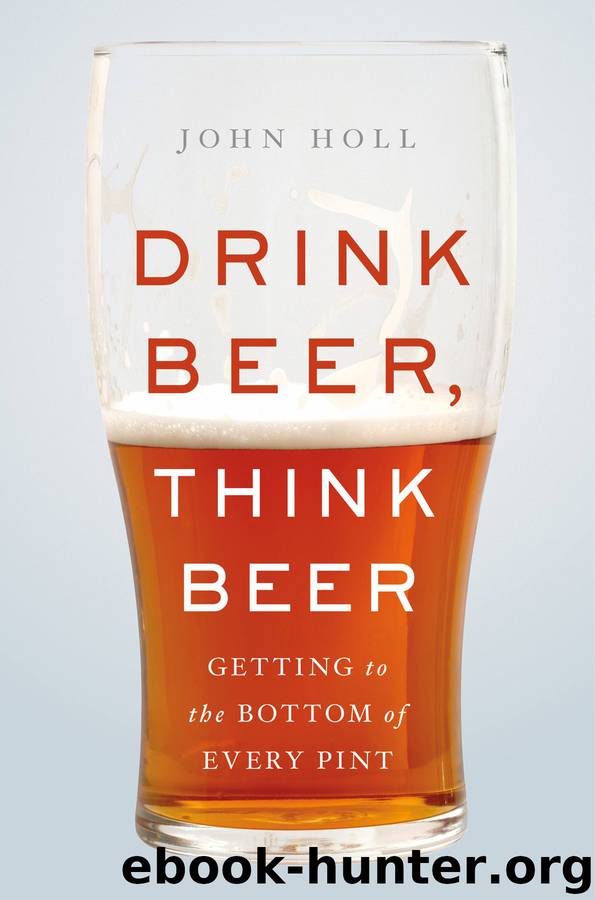Drink Beer, Think Beer by John Holl

Author:John Holl
Language: eng
Format: epub
Publisher: Basic Books
Published: 2018-09-03T16:00:00+00:00
MOUTHFEEL
THE LAST THINGS TO CONSIDER WHEN TASTING A BEER ARE BODY and carbonation: the two main components of a beer’s mouthfeel. Assessing mouthfeel is as simple as taking a sip—of the size we talked about above—and holding it on your tongue for about three seconds. While doing this, think about two things: how the beer feels, weight- and texture-wise, and the level of carbonation. Keep in mind that although it might be natural to assume that dark beers are weightier, color is not always directly correlated with body. Each beer is different, each style has its own specs, and knowing as much about a recipe as possible can help us decide if the beer is truly well made or masquerading.
First let’s tackle body. I hope it’s a fair assumption that you’ve had a Guinness at some point in your life. It’s one of the world’s most popular and recognizable beers. Thanks to its nitro pour, when it arrives at your seat it looks thick and inviting. Take a sip and hold it. Feel the liquid in your mouth, and move your tongue around a bit. You might be surprised to realize that it has the consistency of a glass of water (plus carbonation, of course). Despite its dark and thick appearance, Guinness is actually quite light and mild in body. That’s one of the reasons it’s such easy drinking. Although it’s in the same family as a Russian imperial stout, it is nowhere near as heavy, viscous, and assertive as those beers tend to be. That’s because of the ingredients used to create it. I consulted Craft Beer and Brewing Magazine’s homebrewing recipe archives to get a handle on just what makes these two beers feel so different, and, of course, it’s the malt.
Malt not only gives color to beer, it also contains the sugars that yeast feeds on to create alcohol. The more malt in a beer and the higher its sugar content, the boozier and thicker the beer is likely to be. For a five-gallon homebrew batch of dry Irish stout, a recipe called for 6 pounds of pale malt, 2 pounds of flaked barley, and 1 pound of roasted barley. That equals a dark ale with some mild chocolate and coffee flavor, but mostly the character of light cereal grain and a slightly nutty taste. Five gallons of an imperial stout calls for 19 pounds of two-row malt, 1½ pounds of roasted barely, 12 ounces of chocolate malt, 8 ounces of black patent malt, and 16 ounces of two separate kinds of caramel malt. The larger quantities and greater variety of malt lead to the thicker mouthfeel. If thick beers aren’t your thing, but you like the taste of coffee and chocolate in your beer, a dry Irish stout shouldn’t be intimidating.
As I’ve already said, it’s not just darker beers that are thicker. Hops can lead to a robust body thanks to the oils contained within them. A double IPA, for example, will have a thick and
Download
This site does not store any files on its server. We only index and link to content provided by other sites. Please contact the content providers to delete copyright contents if any and email us, we'll remove relevant links or contents immediately.
Sapiens: A Brief History of Humankind by Yuval Noah Harari(14257)
The Tidewater Tales by John Barth(12609)
Mastermind: How to Think Like Sherlock Holmes by Maria Konnikova(7233)
Do No Harm Stories of Life, Death and Brain Surgery by Henry Marsh(6891)
The Thirst by Nesbo Jo(6832)
Why We Sleep: Unlocking the Power of Sleep and Dreams by Matthew Walker(6620)
Life 3.0: Being Human in the Age of Artificial Intelligence by Tegmark Max(5478)
Sapiens by Yuval Noah Harari(5295)
The Longevity Diet by Valter Longo(5021)
The Body: A Guide for Occupants by Bill Bryson(4978)
The Rules Do Not Apply by Ariel Levy(4866)
The Immortal Life of Henrietta Lacks by Rebecca Skloot(4528)
Animal Frequency by Melissa Alvarez(4399)
Why We Sleep by Matthew Walker(4362)
The Hacking of the American Mind by Robert H. Lustig(4319)
Yoga Anatomy by Kaminoff Leslie(4309)
All Creatures Great and Small by James Herriot(4233)
Double Down (Diary of a Wimpy Kid Book 11) by Jeff Kinney(4209)
Embedded Programming with Modern C++ Cookbook by Igor Viarheichyk(4108)
